Heat Waves
Heat is the top weather-related killer in the United States. Heat-related fatalities were first officially tallied in 1986, and since then an average of 129 people each year have lost their lives as a result of excessive heat. Heat waves develop over a period of days, and therefore don’t evoke the same sense of urgency as, for example, severe thunderstorms and tornadoes.
A heat wave is defined as a period of abnormally and uncomfortably hot and unusually humid weather. Typically a heat wave lasts two or more days. What temperature threshold marks a heat wave varies by geography. For example, a string of four days of 100°F temperatures in Madison, Wisconsin in July would be considered a heat wave because the average maximum temperature in Madison in mid-July is 82°F. Four days of 100°F in Phoenix, Arizona would not be considered a “heat wave”, because the average daily maximum temperature in mid-July in Phoenix is 106°F!
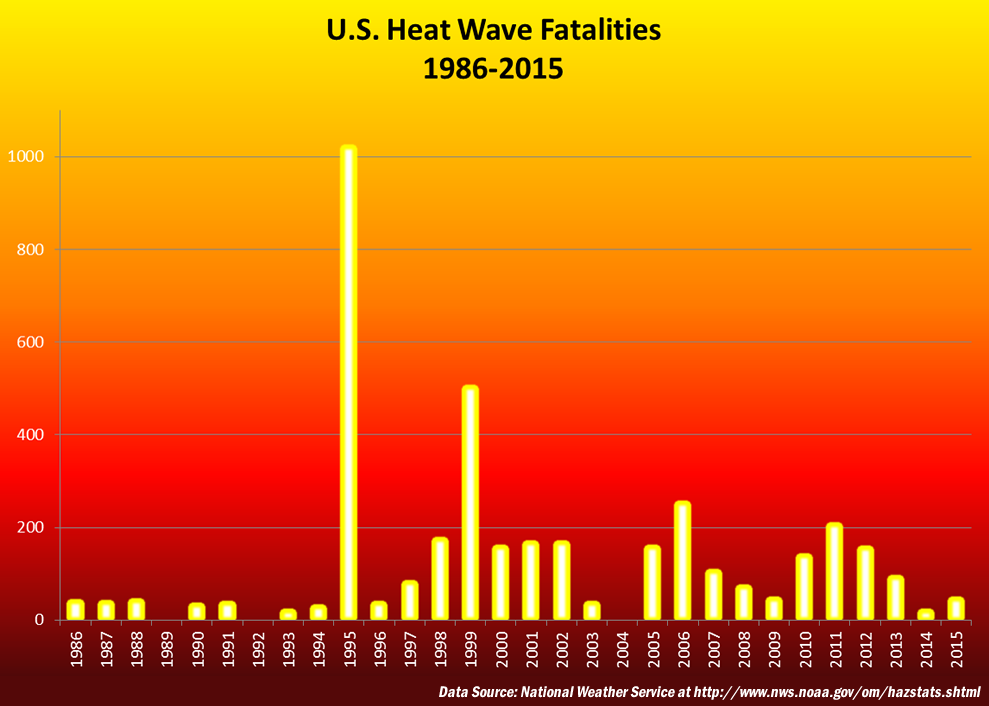
Indices
Heat Index
There is a saying that “it’s not the heat, it’s the humidity.” There is truth to this statement. Excessively hot weather is dangerous in itself, but the addition of higher amounts of moisture to the air does make the effect of the heat worse. As the moisture content of the air increases, the body’s ability to cool itself by evaporation of sweat is impaired. In the central and eastern United States, hot weather is typically accompanied by high humidity. The Heat Index, often referred to as the “apparent temperature”, was developed as a measure of how hot it really feels to the human body when relative humidity is factored with the actual air temperature. See the MRCC Heat Index calculator here. Heat index values were devised for shady, light wind conditions. Exposure to full sunshine can increase heat index values by up to 15°F. In addition, strong winds, particularly with very hot, dry air, can be extremely hazardous.
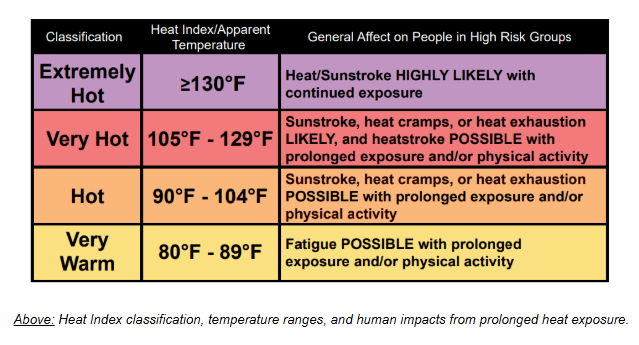
Wet Bulb Globe Temperature (WBGT)
The WBGT is a measure of heat stress popular in the southeastern US that is starting to gain more attention in the central US. In addition to accounting for air temperature and relative humidity, WBGT also factors in wind speed, sun angle, and cloud cover while assuming direct sun exposure.
There are five thresholds of “threat” levels, and these thresholds vary by region of the country. In other words, locations that are more acclimated to extreme heat (like the southeast US) require higher WBGT values compared to less acclimated locations (like the upper Midwest) for a situation to be considered dangerous.
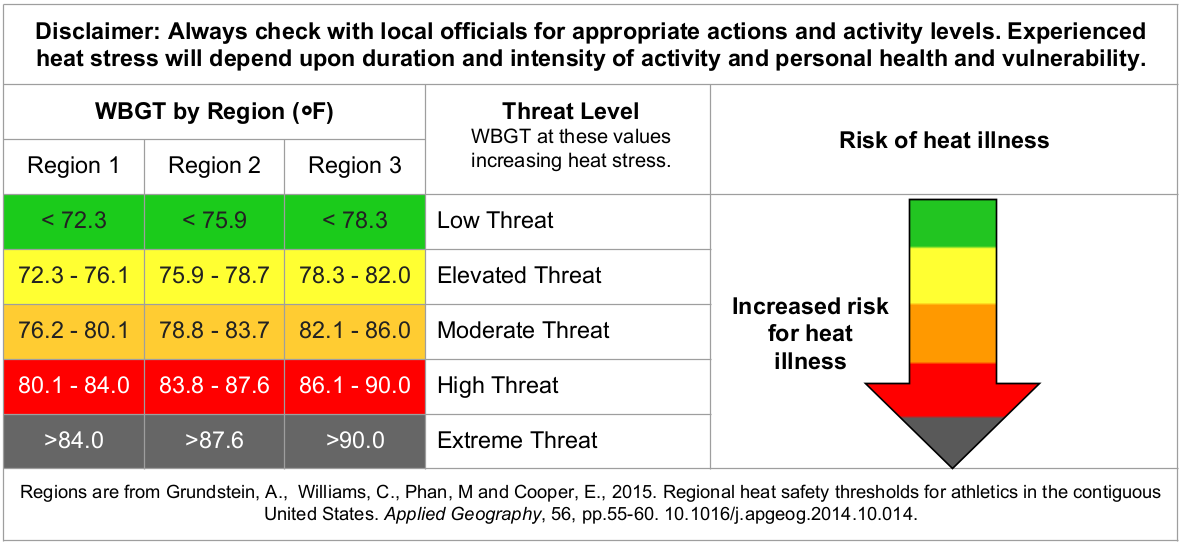
Above: WBGT threshold table provided by the NWS. A map depicting WBGT regions is available at https://www.weather.gov/ict/WBGT.
Heat Risk Forecast
NWS HeatRisk (experimental)
This is a new color-numeric-based index that provides a forecast of the potential level of risk for heat-related impacts to occur over a 24-hour period. According to the NWS, “the biggest difference between the HeatRisk approach and other approaches is that the HeatRisk identifies unusual heat (defined as the warmest 5% of temperatures) specifically for a particular date and location, resulting in daily thresholds that are unique for each location and date. This allows the approach to better account for acclimation (many of us become ‘used to the heat’ and so our thresholds change) and the variation in climatology that we know exists across most regions of the United States.”
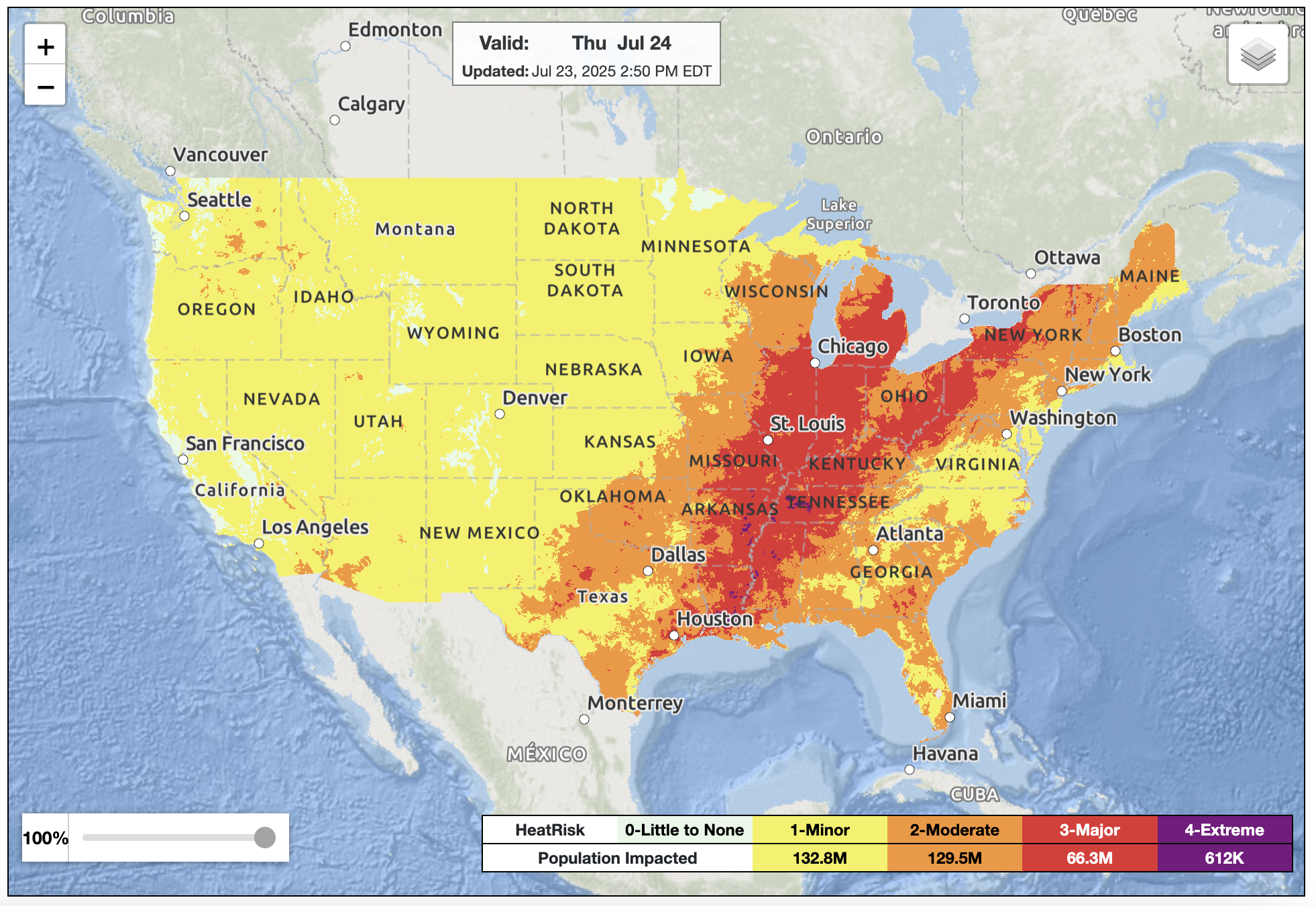
Above: HeatRisk forecast for July 24, 2025 provided by the NWS.
The Dangers of Excessive Heat
The health effects of excessive heat can be cumulative, and typically it takes a few days of oppressive heat and humidity before populations are affected. When the body heats too quickly to cool itself adequately, or when you lose too much fluid or salt through dehydration or sweating, your body temperature rises and heat-related illness may develop. Heat disorders share one common feature: the individual has been in the heat too long or exercised too much for his or her age and physical condition.
Studies indicate that, other things being equal, the severity of heat disorders tends to increase with age. Conditions that cause heat cramps in a 17-year-old may result in heat exhaustion in someone 40 years old, and in heat stroke in a person over 60. Sunburn, with its ultraviolet radiation burns, can significantly retard the skin's ability to shed excess heat.
^Top
Heat Disorders
Sunburn
Most people have probably experienced a sunburn. The primary symptoms are redness and pain. In severe cases there can be swelling of skin, blisters, fever, and headaches. First aid for mild cases (if blisters appear and do not break) consists of using sunburn relief products to relieve pain. If blisters break, apply dry sterile dressing. Serious, extensive cases should be seen by physician.
Heat Cramps
Heat cramps result in painful spasms usually in the muscles of legs and abdomen with heavy sweating. First aid consists of applying pressure on cramping muscles or gentle massage to relieve the spasm. Give sips of water. If nausea occurs, discontinue water.
Heat Exhaustion
Symptoms of heat exhaustion include heavy sweating; weakness; cold, pale, clammy skin; thready pulse (a scarcely perceptible and commonly rapid pulse that feels like a fine mobile thread under a palpating finger); fainting and vomiting, but may have normal temperature. First aid consists of immediately getting the victim out of the sun. Once inside, the person should lay down and loosen his or her clothing. Apply cool, wet cloths. Fan or move victim to air conditioned room. Offer sips of water. If nausea occurs, discontinue water. If vomiting continues, seek immediate medical attention.
Heat Stroke (or Sunstroke):
Symptoms of heat stroke are high body temperature (106° F or higher), hot dry skin, rapid and strong pulse, and possible unconsciousness. Heat stroke is a severe medical emergency! Summon emergency medical assistance (call 9-1-1) or get the victim to a hospital immediately. Delay can be fatal! While waiting for emergency assistance, move the victim to a cooler environment reduce body temperature with cold bath or sponging. Use extreme caution. Remove clothing, use fans and air conditioners. If the victim’s temperature rises again, repeat process. Do NOT give fluids.
Source: Centers for Disease Control and Prevention , National Weather Service .
^Top
Protecting Yourself during a Heat Wave
The first step in protecting yourself is to know what to expect. NOAA’s National Weather Service Forecast offices issue heat-related advisories and warnings as conditions warrant.
Excessive Heat Outlooks are issued when the 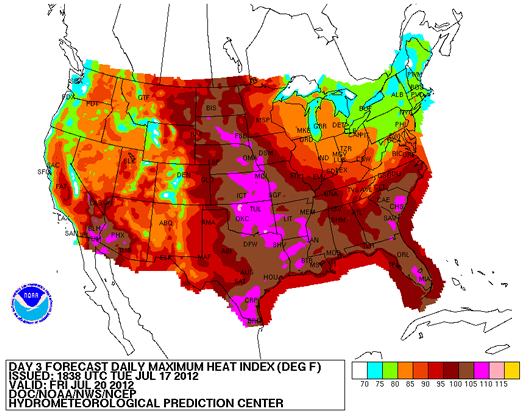 potential exists for an excessive heat event in the next 3-7 days. An Outlook provides information to those who need considerable lead time to prepare for the event, such as public utility staff, emergency managers and public health officials. NOAA’s Hydrometeorological Prediction Center prepares maps of forecasts for mean heat index values and the probability thresholds will be exceeded. See HPC Heat Index Forecasts .
potential exists for an excessive heat event in the next 3-7 days. An Outlook provides information to those who need considerable lead time to prepare for the event, such as public utility staff, emergency managers and public health officials. NOAA’s Hydrometeorological Prediction Center prepares maps of forecasts for mean heat index values and the probability thresholds will be exceeded. See HPC Heat Index Forecasts .
Excessive Heat Watches are issued when conditions are favorable for an excessive heat event in the next 24 to 72 hours. A Watch is used when the risk of a heat wave has increased but its occurrence and timing is still uncertain. A Watch provides enough lead time so that those who need to prepare can do so, such as cities officials who have excessive heat event mitigation plans.
Excessive Heat Warnings/Advisories are issued when an excessive heat event is expected in the next 36 hours. These products are issued when an excessive heat event is occurring, is imminent, or has a very high probability of occurring. The warning is used for conditions posing a threat to life or property. An advisory is for less serious conditions that cause significant discomfort or inconvenience and, if caution is not taken, could lead to a threat to life and/or property.
Additional information on heat waves and heat wave preparedness can be found at NWS Safety Resources . Local warnings and advisories can be found on the National Weather Service website .
Basic Precautions
The American Red Cross has a one-page checklist for preparing for heat waves: Heat Wave Safety Checklist .
^Top
Heat Wave Impacts
Heat waves develop over a period of days, and therefore don’t evoke the same sense of urgency as, for example, severe thunderstorms and tornadoes. Yet, they often have widespread societal impacts in addition to the threats to human health and safety.
Agriculture
Livestock heat stress is a serious concern for livestock producers. It is estimated that heat events in the central U.S. in the past ten years have resulted in direct and indirect financial losses to the cattle industry of over $75 million.
Temperature, wind speed, humidity, and solar radiation can all contribute to heat stress in livestock. Livestock producers need to be proactive before and during a heat wave to prevent the effects of heat stress. For more information, visit the USDA Agricultural Research Service Heat Stress web site . This web site includes heat stress forecasts, a description of impacts of heat stress on cattle, risk factors, and preventive measures. You may also obtain additional information specific to your state by contacting your local cooperative extension office .
Excessive heat also affects the development of row crops (corn, soybeans, wheat) and also many fruit crops (apples, grapes, cherries, etc.). Yields of many crops can be reduced by high heat when it occurs at a critical time in the plant’s development. For example, high temperatures, especially both day and night, occurring during the pollination of corn can significantly reduce yields, especially if conditions are dry. For corn each kernel is one silk fertilized by one pollen grain. The corn silks can be slow to develop, occurring after the pollen has been shed. Or, the silks may dry out, making them unreceptive to pollen.
Soybeans exposed to heat stress during flowering can result in pollen sterility and reduced seed set. Heat stress during the ripening stage of wheat can affect grain quality and yield.
^Top
Urban Living
The buildings and paved areas in cities retain heat and only slowly release that heat back to the atmosphere. This retention of heat means that urban areas are hotter during the day and do not cool as much at night. During heat waves urban residents get little natural relief from the heat. This leads to an increased risk for heat-related illnesses, especially for those residents without air conditioning. Also at higher risk are increased energy consumption, water quality impacts, and impacts on urban infrastructure such as roads and power distribution.
The U.S. Environmental Protection Agency has produced an Excessive Heat Events Guidebook to help community officials and emergency managers prepare and respond to excessive heat events.
Heat Resources
The 1995 Heat Wave in Chicago, Illinois. Illinois State Climatologist web site
Changnon, S.A., K.E., Kunkel, and B.C. Reinke, 1996: Impacts and responses to the 1995 heat wave: a call to action . Bull. Amer. Meteor. Soc., 77, 1497-1506.
The July 1999 Heat Wave in the Midwest.
Kunkel, K.E., S.A., Changnon, B.C. Reinke, and R.W. Arritt, 1996: The July 1995 heat wave in the Midwest: A climatic perspective and critical weather factors . Bull. Amer. Meteor. Soc., 78, 1107-1119.
Klinenberg, Eric, 2002: Heat Wave: A Social Autopsy of Disaster in Chicago. Chicago, IL: Chicago University Press. ISBN 0-226-44322-1.Palecki, M.A., S.A. Changnon, K.E. Kunkel, 2001: The nature and impacts of the July 1999 heat wave in the Midwestern United States: Learning from the lessons of 1995 . Bull. Amer. Meteor. Soc., 82, 1353-1367.
Rieck, T. C., 2009, Heat Index Climatology For The North-Central United States . NOAA Technical Service Publications NWS Central Region, TSP-17.
Westcott, N.E., 2011: The Prolonged 1954 Heat Wave: Impacts and Responses . J. Weather, Climate and Society, 3, 165-176.
Heat Wave Climatologies: References
Ready.gov Kids Pages - Ready Kids!
Emergencies can be scary, but the more you know about them, the better you can deal with what comes your way! This Ready.gov section also has games plus info geared toward parents and educators.
Ready Wrigley's pages at the CDC Office of Public Health Preapredness and Response
Ready Wrigley the dog has printable books, checklists and even an app to help your child learn and prepare for disasters and weather events.